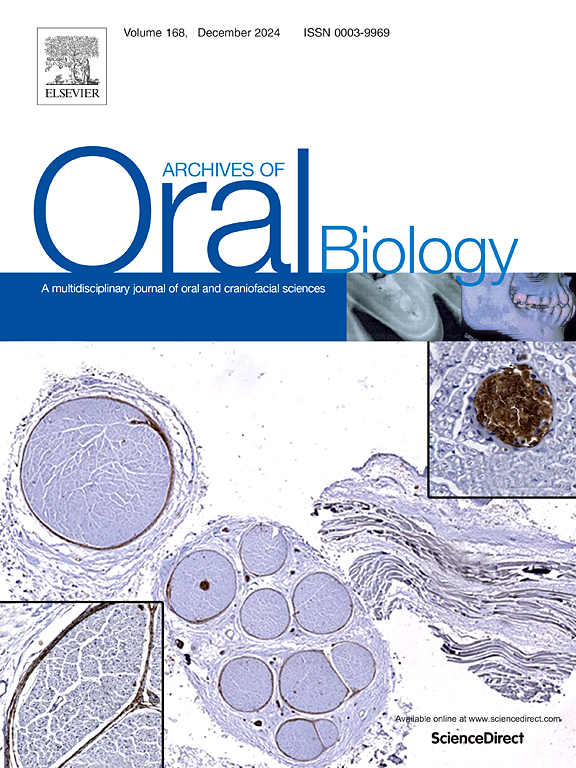taxifolin在体内、体外对龋的预防作用。
IF 2.2
4区 医学
Q2 DENTISTRY, ORAL SURGERY & MEDICINE
引用次数: 0
摘要
目的:探讨taxifolin (taxifolin)对变形链球菌(S. mutans)的体外抑制作用,并评价taxifolin在体内的抗龋作用。设计:检测TAX对变形链球菌的抑菌和抗生物膜性能,并通过实时荧光定量PCR对结果进行初步验证。采用偏振光显微镜和横向显微x线摄影技术观察taxa对牙釉质脱矿的抑制作用。采用显微硬度计、原子力显微镜、横向显微x线摄影等方法分析了TAX对脱矿牙釉质再矿化的影响。建立大鼠龋模型,探讨其体内抗龋作用。结果:TAX对变形链球菌的最低抑菌浓度为1 mg/mL。1 mg/mL TAX抑制生物膜的形成,破坏生物膜结构,有效预防变形链球菌引起的牙釉质脱矿。0.5 mg/mL和1 mg/mL的税务处理组均表现出较高的表面显微硬度恢复百分比,以及较低的表面粗糙度、矿物质损失和损伤深度。此外,1 mg/mL TAX能够抑制大鼠龋齿的发生和发展,同时也被证明是生物学安全的。结论:TAX对变形链球菌有明显的抑制作用,能抑制牙釉质脱矿,促进脱矿牙釉质再矿化,在体内具有良好的抗龋作用。本文章由计算机程序翻译,如有差异,请以英文原文为准。
Preventive effects of taxifolin on dental caries in vitro and in vivo
Objectives
The present study aimed to explore the inhibitory effect of taxifolin (TAX) on Streptococcus mutans (S. mutans) in vitro and evaluated the anti-caries efficacy of TAX in vivo.
Design
The anti-microbial and anti-biofilm properties of TAX were examined on the S. mutans, and the results were preliminarily verified by quantitative real-time PCR. Polarized light microscopy and transverse microradiography were used to detect the effect of TAX on inhibiting enamel demineralization. The effect of TAX on the remineralization of demineralized enamel was analyzed by a microhardness tester, atomic force microscope, and transverse microradiography. The rat dental caries model was constructed to explore the anti-caries effect of TAX in vivo.
Results
The minimum inhibitory concentration of TAX against S. mutans was 1 mg/mL. The 1 mg/mL TAX impeded the biofilm formation, destroyed the biofilm structure, and effectively prevented enamel demineralization caused by S. mutans. Both the 0.5 mg/mL and 1 mg/mL TAX-treated groups exhibited a higher percentage of surface microhardness recovery, along with lower surface roughness, mineral loss, and lesion depth. Additionally, 1 mg/mL TAX demonstrated the ability to inhibit the initiation and progression of caries in rats, while also proving to be biologically safe.
Conclusions
TAX had a significant inhibitory effect on S. mutans, could inhibit enamel demineralization and promote remineralization of demineralized enamel, and showed a promising anti-caries effect in vivo.
求助全文
通过发布文献求助,成功后即可免费获取论文全文。
去求助
来源期刊

Archives of oral biology
医学-牙科与口腔外科
CiteScore
5.10
自引率
3.30%
发文量
177
审稿时长
26 days
期刊介绍:
Archives of Oral Biology is an international journal which aims to publish papers of the highest scientific quality in the oral and craniofacial sciences. The journal is particularly interested in research which advances knowledge in the mechanisms of craniofacial development and disease, including:
Cell and molecular biology
Molecular genetics
Immunology
Pathogenesis
Cellular microbiology
Embryology
Syndromology
Forensic dentistry
 求助内容:
求助内容: 应助结果提醒方式:
应助结果提醒方式:


